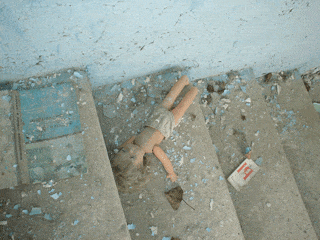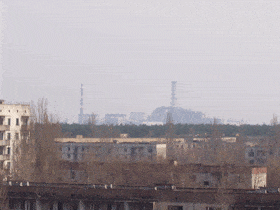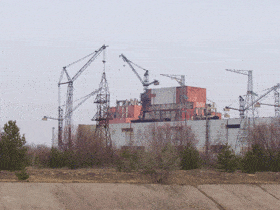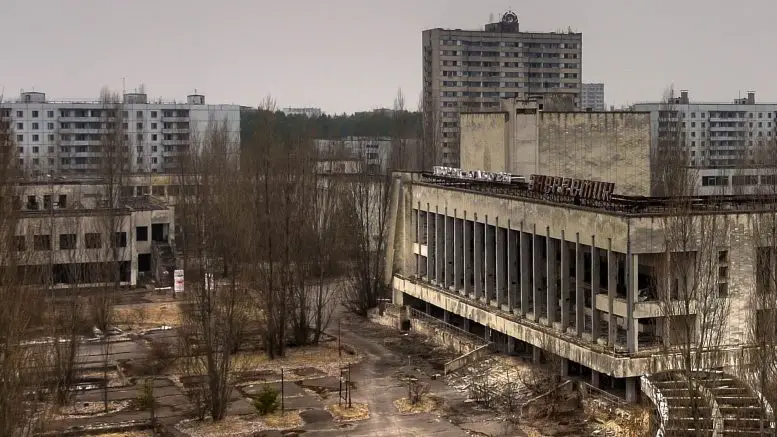
A scene at a former school in the abandoned city of Pripyat, near the Chernobyl disaster site.
On April 26, 1986 the worst nuclear accident in history took place in Chernobyl,
Ukraine as a result of an unnecessary safety test. Workers at Reactor No. 4 turned off the emergency cooling system to find out if there would be enough electricity in the grid systems that cooled the core if the reactor were to lose power. As a result of several factors, including a reactor design flaw, operational errors, and flouted safety procedures, there was a power surge, a steam explosion, and finally a nuclear explosion that shot the reactor’s 500 ton roof and almost nine tons of toxic waste straight up into the air at 1:26 am on Saturday, April 26, 1986.
The extent of the damage to the environment and population are still not fully known. The amount of radioactive material spread was 90 times as much as was delivered by the bomb dropped on Hiroshima. It affected all or parts of Belarus, Ukraine, Russia, Poland, and the Baltic region, and would drift over parts of Europe for several days after the initial explosion. The nuclear accident was not initially communicated – not to the global community, not to the 43,000 residents of the nearby city of Pripyat who went about their daily business as usual. Much about the accident was kept secret for years, until the collapse of the Soviet Union.
The first eight hours after the accident, the Kremlin received misleading information. There was talk of an “accident” and a “fire,” but no word about an explosion. When Moscow found out that radioactivity was involved in the accident, the Kremlin sent militsia to the town to take measurements. The residents of Pripyat noticed an increase of militsia in their city, but didn’t know why. By early afternoon, the radioactive levels in Pripyat were 15,000 times above normal, and by evening – 60,000 times higher. The technicians just thought their equipment wasn’t working properly.
It took five months to put out the radioactive fire. All the first 29 firefighters on the scene died shortly after from radiation poisoning – two that night, the rest in the days following. The first photographer on the scene, riding in a helicopter around Reactor No. 4 – which was still spewing radioactive material into the sky – was able to take 12 photos before his equipment broke down from radiation exposure. The photos are of very poor quality, as the radiation caused white spots to appear in them and made the images grainy.
Once the seriousness of the situation was known, Mikhail Gorbachev, the president of the USSR at the time, quickly gathered the top physicists and nuclear experts at his disposal to assess the situation. Thirty-six hours after the initial explosion, these experts decided the residents of Pripyat must evacuate. Residents were given two hours to gather their belongings. The evacuation of Pripyat’s 43,000 residents took 3.5 hours, using 1,100 buses from Kiev. Residents remember that everyone was in a hurry, but nobody was panicking. The residents of Pripyat were initially told they would be evacuated only for three days. However, to this day, the town is uninhabitable.

A view of reactor four from the vacant apartment blocks of Pripyat.
Many of the town’s residents would die of illnesses related to the accident in the days, months, or years following. Moscow’s Hospital No. 6, the only hospital in the USSR specializing in nuclear wounds, treated many from Pripyat and other nearby-evacuated areas, many of them children.
The initial symptoms of radiation sickness include nausea, vomiting, diarrhea, headache and fatigue. There is then a latency period (usually a few days, but depending on exposure) before the appearance of more severe symptoms such as hair loss, fever, vomiting blood, bloody stool, low blood pressure, dizziness, third degree burns, organ tissue damage, and death. The patients were admitted to Hospital No. 6 while in the latency period. Nurses recall that the patients were feeling pretty good, morale was up, there was a lot of joking around. The nurses, however, knew most of them would soon die.

Reactors five and six, now also abandoned, were under construction at the time of the accident.
Initially, it wasn’t a matter of trying to hide the severity of the accident. Everyone underestimated it, including the scientific delegation of experts Gorbochev called together to assess the situation. In fact, the delegation worked, ate, and slept inside the Pripyat hotel, not far from the reactor. They initially estimated that the reactor would be back in service by May or June.
Everyone, including those in Europe already being affected by the accident, were in the dark. Sweden’s scientists were the first to notice an increase in the radioactivity around one of their nuclear plants. After it became clear that the international community was expressing concern, on April 28, sixty hours after the accident, the Kremlin issued an official announcement.
Soviet pilots were rushed back from the Afghan front. The main issue was to stem the radioactive material that was still spewing from the reactor, making Ukraine, Russia, and all of Europe subject to the mercy of the winds. The pilots’ task was to drop sand, lead and boric acid on top of the reactor to stem the upflow. Some pilots made up to thirty-three trips in one day. After work, they would throw up – signs that they were acquiring radiation poisoning.
On May 1st, six days after the accident, the government encouraged people to go out and participate in the May Day celebrations, even in areas they knew had a radiation level 1,000 times higher than normal. To this day, no study has been done to estimate the number of people that were contaminated due to this advice to go out and celebrate. All footage of the May 1986 celebrations has disappeared from Ukraine archives.
More than 600 people were fatally contaminated trying to put out the radioactive fire that wasn’t responding to water. And soon the scientists’ worst fears were confirmed: the concrete slab beneath the 185 tons of nuclear material was cracking. If it gave out, a second explosion – far worse than the first – would result. It wasn’t revealed until 1991 that there had been serious danger of a second explosion, which, if it had taken place, would have wiped out half of Europe and made Europe, Ukraine, and parts of Russia uninhabitable for approximately 500,000 years.
To avert this disaster, on May 12, miners from Tula, Russia were rushed into the area to approach the reactor from underground. Their task: to build a refrigeration-device that would cool the burning radioactive material. Their average age was 20-30, and they knew it was dangerous work, but they were not fully informed of the risks. It was actually relatively safe below ground – it was when they surfaced from the hole that that they had to run as fast as they could to get out of the highly contaminated area – each second of that run to safety would have consequences on the rest of their lives. They wore no protective gear, not even shirts – as the burning radioactive material made the temperature so hot that their masks would soak with sweat in a matter of seconds. It’s estimated that ¼ of these minors died before age 40, though no official statistic exists. The rest who are alive today have serious health issues. More than 10,000 miners participated in the effort.

An aerial photo of ground zero, taken a few days after the accident.
Also aiding the clean-up were 100,000 troops and 400,000 civilians, called “liquidators.” Many of them wore masks at first, but then “forgot about them.” Hunters were sent into the area – all animals in the area, including cats and dogs, had to be killed to prevent the contamination from spreading.
Eight weeks after the initial explosion, it was time for the liquidators to attack the main problem of building a sarcophagus of steel and concrete around the reactor. The main problem was how to build such a structure under circumstances where workers can only work for a few minutes or less before they must be swapped with new workers, in order to prevent severe contamination. To accomplish the task, the sarcophagus was built in pieces in other areas, then brought in to Chernobyl and assembled like a giant jigsaw puzzle. Remote-controlled machines would put the slabs in place, but humans would have to hurriedly get the machines ready.
Before the sarcophagus could be completed, pieces of highly radioactive debris from the explosion would have to be removed from the top of the roof. At first, they used remote control machines, but the level of radioactivity was so high that after a few days the machines would break down or malfunction and fall from the roof.
They realized people would have to do this task. The roof was so radioactive that a person could only work for 40-45 seconds before receiving dangerous levels of contamination. They would scrape off a few shovel fulls at a time, then be replaced with other workers. Workers reported that after this 45 seconds they could hardly move: a combination of contamination and the heavy steel suits they wore to counteract the radioactivity as much as possible. They would also vomit afterwards. One worker reported it was like having your blood sucked by a vampire. 3,500 people participated. Most didn’t want to, but they knew somebody had to do it. Nobody knew the exact level of radiation at the time.
Clean-up after the accident cost 18 billion dollars. A new Greenpeace report has revealed that the Chernobyl disaster could be responsible for more than a quarter of a million cancer cases and nearly 100,000 cancer deaths. The sarcophagus has held, but it needs a replacement, which has been under construction since 2007. The project is behind schedule due to funding issues. Nobody knows what is happening inside the reactor.



